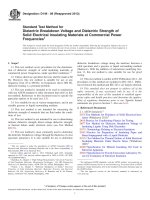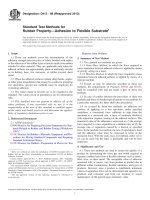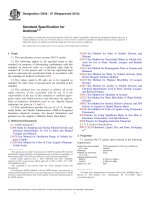Astm d 904 99 (2013)
Bạn đang xem bản rút gọn của tài liệu. Xem và tải ngay bản đầy đủ của tài liệu tại đây (75.23 KB, 3 trang )
Designation: D904 − 99 (Reapproved 2013)
Standard Practice for
Exposure of Adhesive Specimens to Artificial Light1
This standard is issued under the fixed designation D904; the number immediately following the designation indicates the year of
original adoption or, in the case of revision, the year of last revision. A number in parentheses indicates the year of last reapproval. A
superscript epsilon (´) indicates an editorial change since the last revision or reapproval.
3.2 Definitions of Terms Specific to This Standard:
3.2.1 irradiance, n—(1) the rate at which light energy falls
on a unit area of surface (W/m2), or (2) the radiant power
incident upon a unit area of surface.
3.2.2 radiant exposure (or light dosage), n—(1) the accumulated light energy which has fallen on a unit area over time
(J/m2), or (2) the irradiance integrated with respect to time.
3.2.3 spectral irradiance, n—the distribution of irradiance
in accordance with wavelength.
3.2.3.1 Discussion—Spectral irradiance is usually shown as
a curve relating irradiance (ordinate) and light wavelength
(abscissa). Because shorter wavelength UV is usually more
damaging than longer wavelength UV, lamps with different
spectral irradiance curves can cause drastically different
amounts of UV damage, even if they produce the same total
irradiance.
3.2.4 spectral power distribution (SPD), n—the amount of
radiation present at each wavelength.
3.2.4.1 Discussion—The SPD can be expressed by power in
watts, irradiance in watts/square metre, or energy in joules. The
shape of the SPD would be identical in all of these units.
Fluorescent lamps are frequently described by relative SPD’s
which show the amount of radiation at each wavelength as a
percentage of the amount of radiation at the peak wavelength.
3.2.5 UV-A, n—ultraviolet light in the wavelength band
between 315 and 400 nm.
3.2.6 UV-B, n—ultraviolet light in the wavelength band
between 280 and 315 nm.
1. Scope
1.1 This practice covers the basic principles and operating
procedures for ultraviolet (UV) light aging (with or without
water) of adhesive bonded joints having at least one glass or
transparent adherend, using fluorescent UV (see Method A) or
xenon-arc light sources (see Method B).
1.2 This practice is limited to the apparatus for obtaining,
measuring, and controlling the aging conditions, and to the
procedures for exposure. Sample preparation, strength, test
conditions, and evaluation of the results are described in other
ASTM test methods or specifications.
1.3 The values stated in SI units are to be regarded as
standard. No other units of measurement are included in this
standard.
1.4 This standard does not purport to address all of the
safety concerns, if any, associated with its use. It is the
responsibility of the user of this standard to establish appropriate safety and health practices and determine the applicability of regulatory limitations prior to use.
2. Referenced Documents
2.1 ASTM Standards:2
D907 Terminology of Adhesives
G151 Practice for Exposing Nonmetallic Materials in Accelerated Test Devices that Use Laboratory Light Sources
G154 Practice for Operating Fluorescent Ultraviolet (UV)
Lamp Apparatus for Exposure of Nonmetallic Materials
G155 Practice for Operating Xenon Arc Light Apparatus for
Exposure of Non-Metallic Materials
4. Significance and Use
3. Terminology
4.1 This practice is for determining the effects of UV light,
or UV light and water, on adhesive bonded joints under
controlled but artificial conditions. The results of this practice
can be used for comparing the relative durability of several
adhesives in a specific laboratory UV exposure.
3.1 Definitions—Many of the terms in this practice are
defined in Terminology D907.
4.2 This practice is not for determining a forecast of the life
of an adhesive bond in service. It is only for determining the
relative durability of different adhesives compared to each
other.
1
This practice is under the jurisdiction of ASTM Committee D14 on Adhesives
and is the direct responsibility of Subcommittee D14.40 on Adhesives for Plastics.
Current edition approved July 1, 2013. Published July 2013. Originally approved
in 1946. Last previous edition approved in 2008 as D904 – 99 (2008). DOI:
10.1520/D0904-99R13.
2
For referenced ASTM standards, visit the ASTM website, www.astm.org, or
contact ASTM Customer Service at For Annual Book of ASTM
Standards volume information, refer to the standard’s Document Summary page on
the ASTM website.
4.3 The results obtained may vary between the different
light sources (xenon-arc or fluorescent UV), because of the
different spectral-irradiance of the lamps. Adhesives should not
Copyright © ASTM International, 100 Barr Harbor Drive, PO Box C700, West Conshohocken, PA 19428-2959. United States
1
D904 − 99 (2013)
be compared to each other based on their performance under
different types of light sources.
5.6 Expose the specimens for 168 h or multiples thereof,
unless a significant change is observed in a shorter time.
4.4 The results obtained may vary when operation conditions are varied within the limits of a given method. The results
may also vary when exposures are performed on instruments
made by different manufacturers. Comparisons between materials must only be made when they are tested at the same time
in the same instrument. Be sure to accurately report the
operating conditions.
6. Method B—Xenon Arc
6.1 Apparatus—Any xenon arc apparatus in accordance
with Practices G151 and G155.
6.2 Filter configuration in accordance with Practices G151
and G155.
6.3 Irradiance Level—Set the irradiance level to a level
selected by mutual agreement.
4.5 The type and UV transmittance characteristics of the
transparent adherend used can have a significant effect on the
rate and type of degradation of the adhesives being tested.
Comparisons between adhesives must only be made when
tested on transparent adherends of the same type (preferably
the same lot) with the same UV transmission.
6.4 Time/Temperature Cycles—Program the unit for one of
the following light/spray cycles:
6.4.1 Cycle 1—40 min of light followed by 20 min of light
and specimen spray followed by 60 min of light followed by 60
min of dark. During the light cycle operate at a 63 6 3°C
black-panel temperature and 50 6 5 % relative humidity.
During the dark cycle operate at 38 6 2°C black-panel
temperature and 95 6 5 % relative humidity.
6.4.2 Cycle II—Continuous light without water at a blackpanel temperature of 60 6 3°C.
4.6 This practice is not for determining the effects of
atmospheric pollutants, biological organisms, salt, or freeze/
thaw cycles.
5. Method A—Fluorescent UV
5.1 Apparatus—A fluorescent UV and condensation chamber in accordance with Practices G151 and G154.
6.5 Other filters, irradiance levels, relative humidities,
temperatures, and time cycles are acceptable, as long as they
are reported in accordance with Section 7.
5.2 Lamp Type—Use fluorescent UV-A lamps, with a peak
emission at 343 nm.
6.6 Operate the apparatus in accordance with Practices
G151 and G155.
NOTE 1—UV-A lamps are preferable to UV-B lamps, because UV-A
wavelengths can pass through the transparent portion of the test specimen
without being absorbed, whereas most of the UV-B wavelengths are
filtered out by the glass.
6.7 Expose the specimens for either (1) 168 h or multiples
thereof, unless a significant change is observed in a shorter
time, or (2) a given amount of radiant exposure.
5.2.1 Other fluorescent UV lamps meeting the size and
electrical characteristics in 5.2 may be used by prior
agreement, provided that the lamp and spectral power distribution are reported in conformance with Section 7. Use of
lamps other than those specified in 5.2 may result in significant
differences in test results.
7. Report
7.1 Report the following information:
7.1.1 Type and model of exposure apparatus and the manufacturer’s designation.
7.1.2 Type of light source and the manufacturer’s designation. If a xenon-arc device is used, report the filter combination
and irradiance setting.
7.1.3 Specimen temperature setting.
7.1.4 Time cycle.
7.1.5 Relative humidity if controlled.
7.1.6 Number of hours of exposure, or radiant exposure.
7.1.7 Type of specimen and property evaluated for change
due to light effects.
7.1.8 Type, thickness, and (optionally) UV transmission
characteristics of transparent adherend used. If UV transmission is reported, describe how it was measured.
7.1.9 Mean and precision of property measured before
exposure.
7.1.10 Mean and precision of property measured after
exposure.
5.3 Specimen Mounting—Mount the specimens in the specimen holders so that the UV passes through the transparent
adherend to reach the adhesive joint or so that the joint is
exposed to the effects of condensation (if applicable). Use a
suitable backing panel to ensure that vapor does not escape
from the test chamber around the test specimen. When the test
specimens do not completely fill the racks, fill the empty
spaces with blank panels to maintain the test conditions within
the chamber.
5.4 Time/Temperature Cycles—Program the apparatus to
achieve the desired test conditions, as follows:
5.4.1 Cycle I—4 h UV at 60 6 3°C followed by 4 h
condensation at 50 6 3°C, for applications where the adhesive
will be exposed to moisture.
5.4.2 Cycle II—24 h UV at 60 6 3°C with no condensation,
for applications where moisture is not a factor.
5.4.3 Other temperatures and time cycles are acceptable, as
long as they are reported in accordance with Section 7.
7.2 Follow the section on Report contained in Practices
G151 and G154 or Practice G155, as appropriate.
8. Precision and Bias
NOTE 2—Temperatures are black-panel temperatures measured in the
panel rack.
8.1 It is not practicable to specify the precision and bias of
this practice because this practice limits itself to the relative
durability of different adhesives compared to each other.
5.5 Operate the apparatus in accordance with Practices
G151 and G154.
2
D904 − 99 (2013)
9. Keywords
9.1 adhesive; artificial light; ultraviolet light
ASTM International takes no position respecting the validity of any patent rights asserted in connection with any item mentioned
in this standard. Users of this standard are expressly advised that determination of the validity of any such patent rights, and the risk
of infringement of such rights, are entirely their own responsibility.
This standard is subject to revision at any time by the responsible technical committee and must be reviewed every five years and
if not revised, either reapproved or withdrawn. Your comments are invited either for revision of this standard or for additional standards
and should be addressed to ASTM International Headquarters. Your comments will receive careful consideration at a meeting of the
responsible technical committee, which you may attend. If you feel that your comments have not received a fair hearing you should
make your views known to the ASTM Committee on Standards, at the address shown below.
This standard is copyrighted by ASTM International, 100 Barr Harbor Drive, PO Box C700, West Conshohocken, PA 19428-2959,
United States. Individual reprints (single or multiple copies) of this standard may be obtained by contacting ASTM at the above
address or at 610-832-9585 (phone), 610-832-9555 (fax), or (e-mail); or through the ASTM website
(www.astm.org). Permission rights to photocopy the standard may also be secured from the ASTM website (www.astm.org/
COPYRIGHT/).
3









